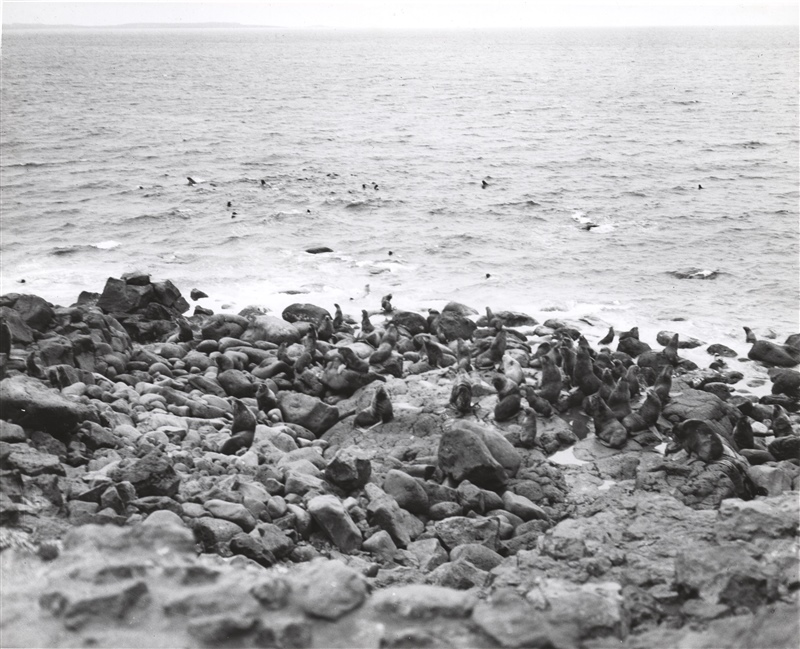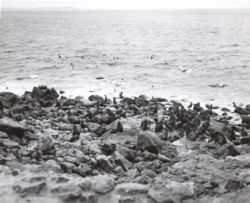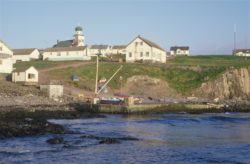
Mayor Patrick Pletnikoff makes the case for St. George Unangan Heritage National Marine Sanctuary
By: the Honorable Patrick Pletnikoff, Mayor, St. George, Alaska

Fur seals on a rocky beach at the Pribilof Islands in Alaska. Photo: NOAA Central Library Historical Fisheries Collection
St. George Island is home to some of the world’s most magnificent biodiversity and natural beauty. Enormously rich populations of Northern fur seals, Steller Sea Lions, otters, cetaceans and over 200 species of sea birds have long been a source of wonder and benefit to our community and visitors. Today, the global gem that is our marine environment is experiencing significant declines that threaten livelihoods and our Unangan way of life. In response, the Unangan people of St. George Island submitted a proposal to NOAA for the creation of an Unangan Heritage National Marine Sanctuary. We have two more years to make this a reality.
St. George is one of the Pribilof Islands. Ours is a small Unangan community of approximately 70 people located in the middle of the Bering Sea, north of the Aleutian Islands. Together with our neighbor St. Paul, our islands are sometimes described as the “Galapagos of the North.”
Approximately 50 percent of the world-wide population of Northern fur seals inhabit the Pribilof Islands during their breeding and pup-rearing seasons from June through November. The population is down from 1.2 million seals thirty years ago, to its current population of 475,000. St. George also provides crucially important habitat for Steller Sea Lions which are also declining.
St. George and the Pribilof Islands provide essential breeding and rearing habitat for sea birds numbering approximately two and a half million. Many of these birds, such as murres, kittiwakes parakeet auklets, sooty shearwaters, tufted and horned puffins, and many others, travel hundreds or thousands of miles from wintering habitat, making our seabird population remarkably diverse and globally significant.
The biologically rich waters around St. George are also home to significant fish populations that provide essential prey for marine mammals, catch for fishermen and a crucial food source for the Unangan people of St. George. These include walleye pollock, Pacific halibut, snow crab and red king crab. Larvae and juveniles of these species rear in great numbers within the waters just off of our islands, supporting fisheries that are economically important for St. George residents and providing one of our few sources of cash income. The Bering Sea, and the Pribilof Domain in particular, provides a reservoir of older female halibut that contributes disproportionately to the spawning biomass of the entire coast-wide Pacific halibut population.
The Pribilof Islands provide essential habitat in three crucial ways:
Interaction of the islands with the Bering Sea shelf-break current generates a circular, clock-wise flow around the islands, generating a retention zone where the developing, early life stages of myriad species of marine organisms are densely concentrated. This retention zone extends approximately 30 miles seaward of the Pribilof Islands. The aggregations of marine life in this area, known as the “Pribilof Domain,” has been a reliable feeding grounds for marine mammals, sea birds, fish and shellfish.
St. George provides unique breeding and rearing habitat for marine mammals and seabirds, including convenient marine haul-outs and rookeries for Northern fur seals and Steller Sea Lions, and widespread nesting sites for seabirds.
And finally, our islands are far from other landmasses, making them well protected from terrestrial predators that could decimate breeding aggregations of marine mammals and seabirds. We Unangan people protect the wildlife on our islands.
This combination of relatively safe breeding and rearing habitat situated in the midst of exceptionally rich feeding grounds makes the waters around St. George easily among the most productive and important anywhere on earth.
Tragically, this habitat – and, with it, the fate of St. George’s community and Unangan cultural heritage – is now threatened. Marine mammal and bird populations have been in steady decline, as confirmed by both science and the day-to-day observations and experiences of our community. Our skies, once filled with sea birds, seem nearly empty. As has been widely reported in the news and seen with our own eyes, common murres and puffins have been dying off, and many birds are not laying eggs as they have in the past. The populations in our fur seal rookeries, once home to millions, are now at an estimated 475 thousand and their decline continues. The Western Steller Sea Lion population has taken an equally dramatic turn: in the past three generations, their population has declined approximately 80 percent, making the species endangered, according to IUCN.
These declines are causing grave, existential concerns within our Unangan community. We depend heavily on the sea’s resources, both materially and spiritually. Our communities have for millennia relied heavily on harvests of marine mammals, seabirds, halibut, crab and other fin- and shellfish for our diet. The activities and products associated with subsistence harvests – from capture to processing to sharing in the consumption – are crucial to maintaining our Unangan culture.
Sustaining these populations requires maintaining ecosystem diversity through the protection of our island’s wide variety of representative and unique habitats. The waters around St. George and the Bering Sea face multiple stresses and additional threats are on the horizon as waters warm, sea ice recedes and international commercial interest in the Arctic grows rapidly. Conservation is urgently needed to protect St. George’s precious marine life, to build resilience and to save our community from its continued downward economic spiral and create a sustainable economy for the future.
In the face of these challenges, our community concluded that the very best option, the one that would take into account all points of view, was the creation of a national marine sanctuary. Accordingly, St. George submitted a nomination to NOAA to create the St. George Unangan Heritage National Marine Sanctuary in the waters immediately surrounding our island, extending approximately 30 miles seaward, except in the direction of St. Paul, where it would extend 20 miles – a sanctuary that would be limited in size while providing outsized benefits to our community and the region by ensuring that our marine life rebounds and flourishes for generations to come.

The boat landing on St. George Island, Alaska. Photo: Allen Shimada/NOAA/NMFS/OST/AMD
